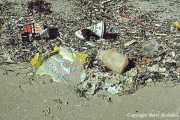|
Sand dunes
The information presented here has been written by Ted Brambleby, Adventure Education,
Marine Environments Field Study and Resource Centre, Hastings Point Beach, NSW
|
If we look upon the Environmental barriers of beach and dunes as a skin structure that protects the vitality and vulnerability of inner eco systems or "tissues" it becomes easy to appreciate acts of ignorant misuse or deliberate abuse. |
 Beach litter
Beach litter |
Rubbish that gets flushed down storm water drains might be temporarily our of sight but after being gushed into our rivers or straight out to sea will if it has a floating component invariably end up on our beaches as ugly litter or Jetsam. The look of our skin often reflects the state of our inner health, what we allow into our blood stream and what chemical abuse we expose our outer bodies too.
Sea mammals (seals) sea birds, fish etc are part of a web indispensable to the wellbeing of coastal inter dependant ecosystems which comprise many links or bridges between these environments eg flathead, mullet, black bream, pelicans, cormorants, terns and fish can be often seen with masses of entangled fishing line hooked into their mouths.
The 20% of Tasmanian breeding seals with circulation impairing and ulcer forming neck collars made from fishing ropes, nets or bait box straps ebbing in and out on beach tides and the number of terminally ill turtles which mistakenly ingest the plastic bags for sea jelly are all legacies of our indifference to the tolerance of oceans faced with our growing epidemic of refuse. |